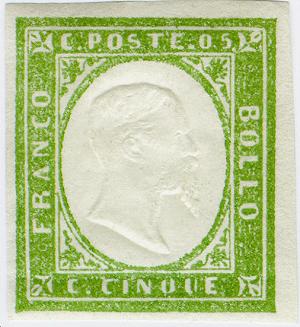
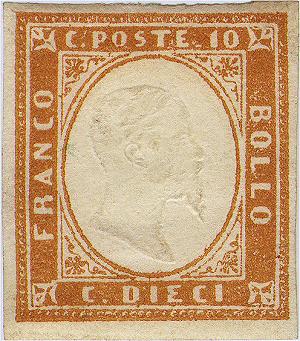
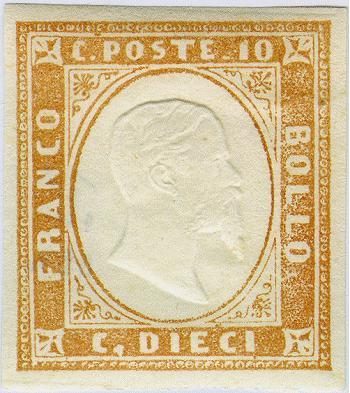
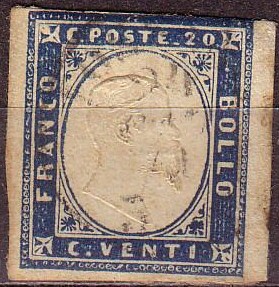
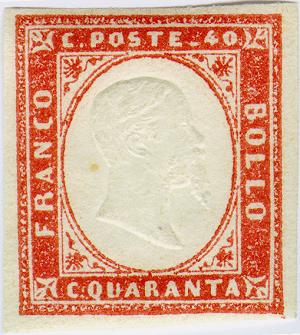

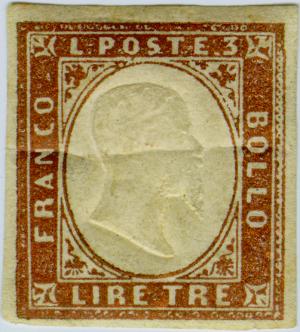
Sardegna
Return To Catalogue - Sardinia, part 1 - Italy
Note: on my website many of the
pictures can not be seen! They are of course present in the cd's;
contact me if you want to purchase them: evert@klaseboer.com.
With thanks to Lorenzo, (check his excellent website on Italian States!) who kindly set some of his images at my disposal.
For stamps issued in Sardinia before 1855, click here.
5 c green 10 c brown 20 c blue 40 c red 80 c yellow 3 L brown
Value of the stamps |
|||
vc = very common c = common * = not so common ** = uncommon |
*** = very uncommon R = rare RR = very rare RRR = extremely rare |
||
| Value | Unused | Used | Remarks |
| 5 c | * | * | |
| 10 c | * | * | |
| 20 c | ** | * | |
| 40 c | * | *** | |
| 80 c | * | R | |
| 3 L | R | RRR | |
Perforated stamps and an imperforated stamp of 15 c in the same design are issued in Italy in 1862. The 3 L is rare in cancelled condition. The 10 c exists in many different colour shades.
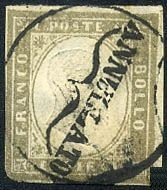
I've been told that this 'ANNULATO' is a cancel from Sicily
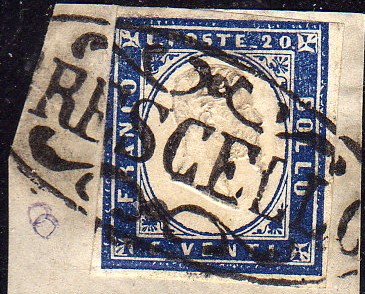
I'm not certain if this fancy 'RESCELLO' cancel is genuine or not
Stamps with inverted heads exist, they are either printer's waste (some very rare ones have been postally used) or forgeries.
Fournier offered these inverted heads in his 1914 pricelist as first choice forgeries (all 6 values for 2 Swiss Francs). By the way, he also offers the 'normal' serie (same price).

Fournier inverted head forgeries.
Sperati also made forgeries with inverted head (the 5 c, 10 c, 20 c and 80 c). He bleached out the design of a genuine stamp, leaving the embossed center intact and then printed a new design, inverted, on top of it. In this way the experts were fooled; they tried to establish if the embossing was genuine (and it is in these forgeries!):
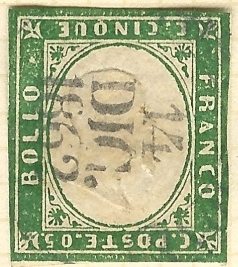
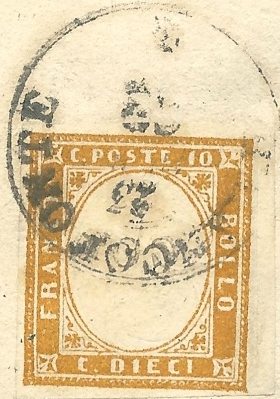
Sperati forgeries, images obtained from Richard Frajola's
website: http://www.seymourfamily.com/rfrajola/Sperati/sitaly.htm



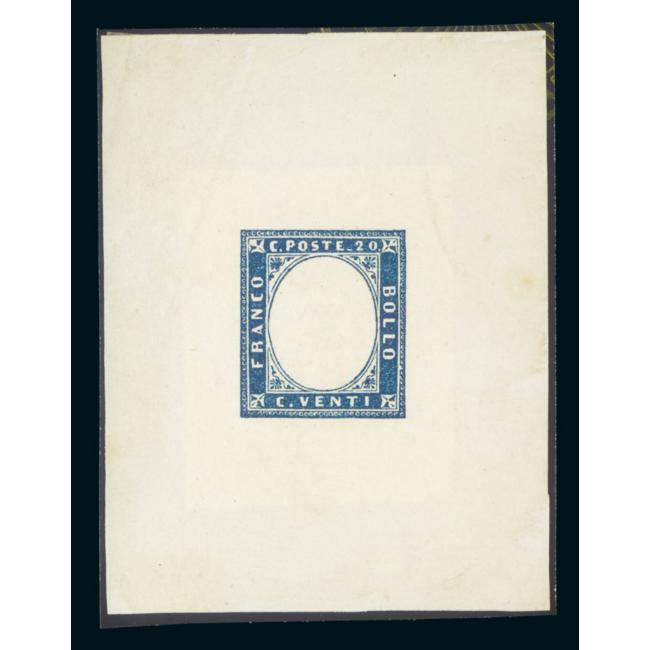
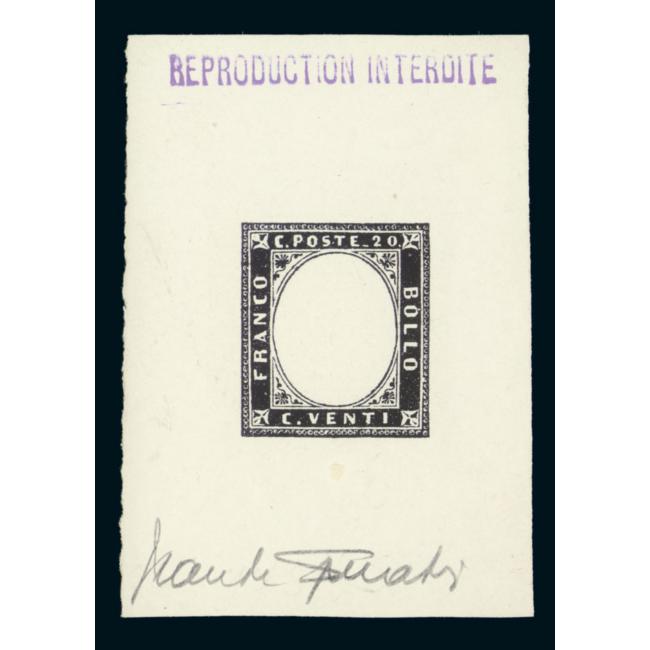

Sperati 'proofs'.
The above stamps could be proofs, the embossed head is much smaller than in the normal stamps. I have also seen a 10 c blue in this design.
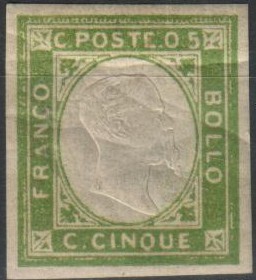

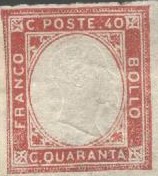
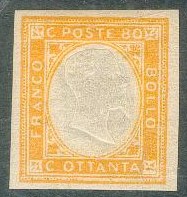
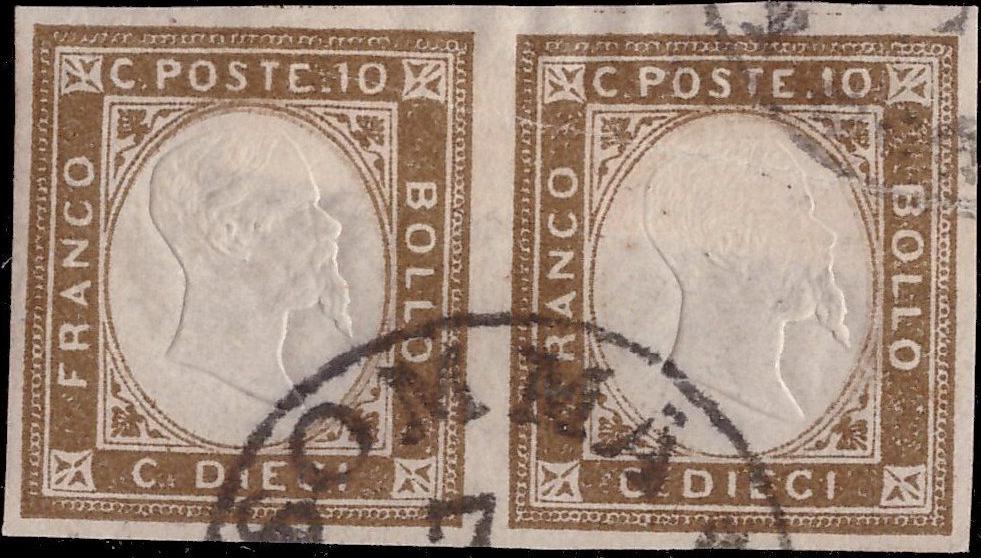
Some other 'mystery' stamps with much larger inscriptions than
the normal stamps, sometimes sold as proofs but I think they are
forgeries? Note that all the 'O's are very rounded
The plates of at least the 5 c, 20 c and 40 c ended up in the hands of a certain David Cohn of Berlin (source: 'Focus on forgeries' by Varro E. Tyler). Reprint-forgeries were made with these plates by him after some retouching. The differences are small but can be seen, the colours are different from those of the genuine stamps. For example, in the 5 c reprint-forgery there is a break in the ornamental design at the left upper corner surrounding the ellipse (below the asterisk). In the 20 c there is a blue dot to the right of the upper right ornament surrounding the ellipse with the portrait of the king. In the 40 c there is a small break in the outer curved line of the ellipse just in front of the king's forehead and in the upper right corner with the ornament, the horizontal line is broken. These 'reprints' also exist perforated 11 1/2 to turn them into the first issues of Italy (however, the genuine stamps of Italy are perforated 11 1/2 x 12).


(Distinghuishing characteristics for the reprint-forgeries of 5 c
and 40 c)

(Distinghuishing characteristic for the reprint-forgery of 20 c;
small dot)
Note that the 5 c perforated was never issued in Italy, this is a bogus reprint!
There seem to be another reprint-forgery made by Usigli in Florence, I have no further information.
Fournier forgeries are rather deceptive. A 3 L forgery with 'FAUX' overprint (most likely Fournier forgery):

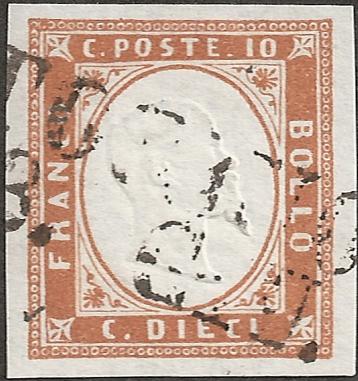
A perforated 3 L stamp, probably a Fournier forgery. Next to it a
10 c Fournier forgery with the forged 'TORINO 13. GIU' cancel as
shown below.

Fournier inverted head forgeries.
Distinguishing characteristics of the Fournier
forgeries:
5 c: The 'Q' of 'CINQUE' is different
10 c: The '1' of '10' should have a flattened top part, also the
triangular ornament under the 'PO' of 'POSTE' should be broken in
the genuine stamps, in the Fournier forgery, it is intact.
20 c: The 'N' of 'VENTI' is too wide.
40 c: The 'Q' of 'QUARANTA' is an 'O' and the '4' is more open on
top than in the genuine stamps
80 c: the first 'A' of 'OTTANTA' is slanting backwards
3 L: in my opinion, the '3' is too small

The forged cancels used by Fournier as shown in 'The Fournier
Album of Philatelic forgeries', I don't know on which issue
Fournier applied these forged cancels. Reduced sizes. The
"TORINO 13. GIU" cancel and "FOLIGNO 20 DIC
68" (see Papal States) was used on
forgeries of this set. Another forged cancel that was used by
Fournier is "BOLOGNA 21 GEN 59"

Fournier forgery with "FOLIGNO 20 DIC 68" forged
cancel.
There seem to exist 'misprints' of the 20 c in the colour yellowish brown (instead of blue). This is however achieved through the application of certain chemicals. I haven't seen this kind of forgery.
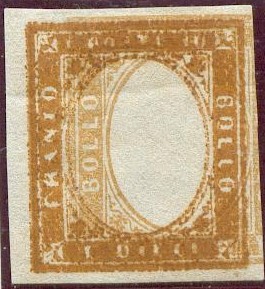
A doubly printed 10 c with no center embossing; probably printers
waste.
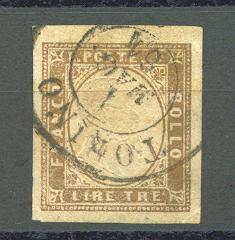
(Reduced size)
In the above 3 L forgery the letters of the inscription are different.
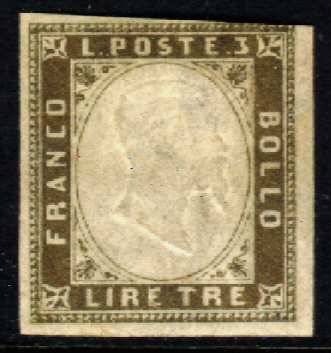
(And another forgery of the 3 L)
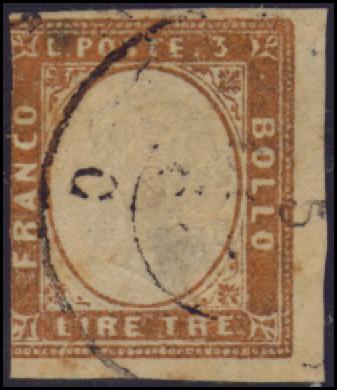
(Forgery of the 3 L stamp, the '3' is placed too far to the left)
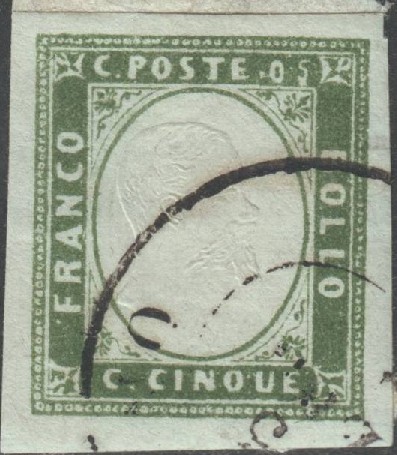
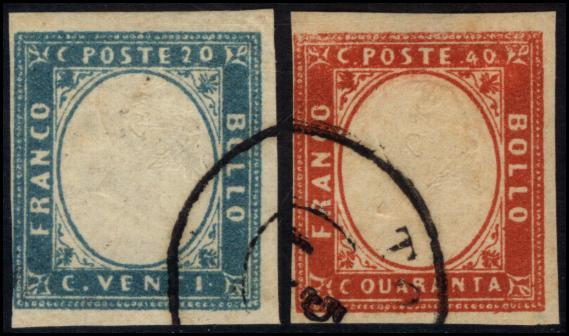
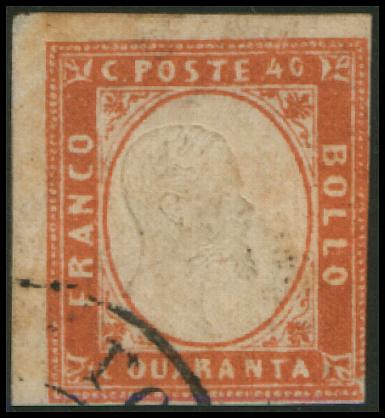
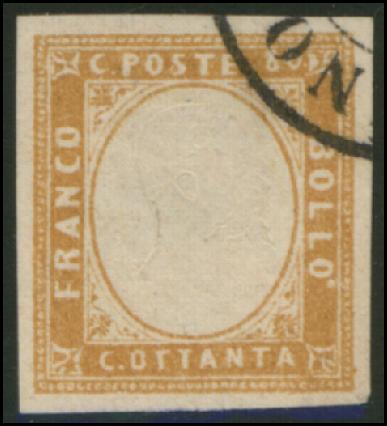
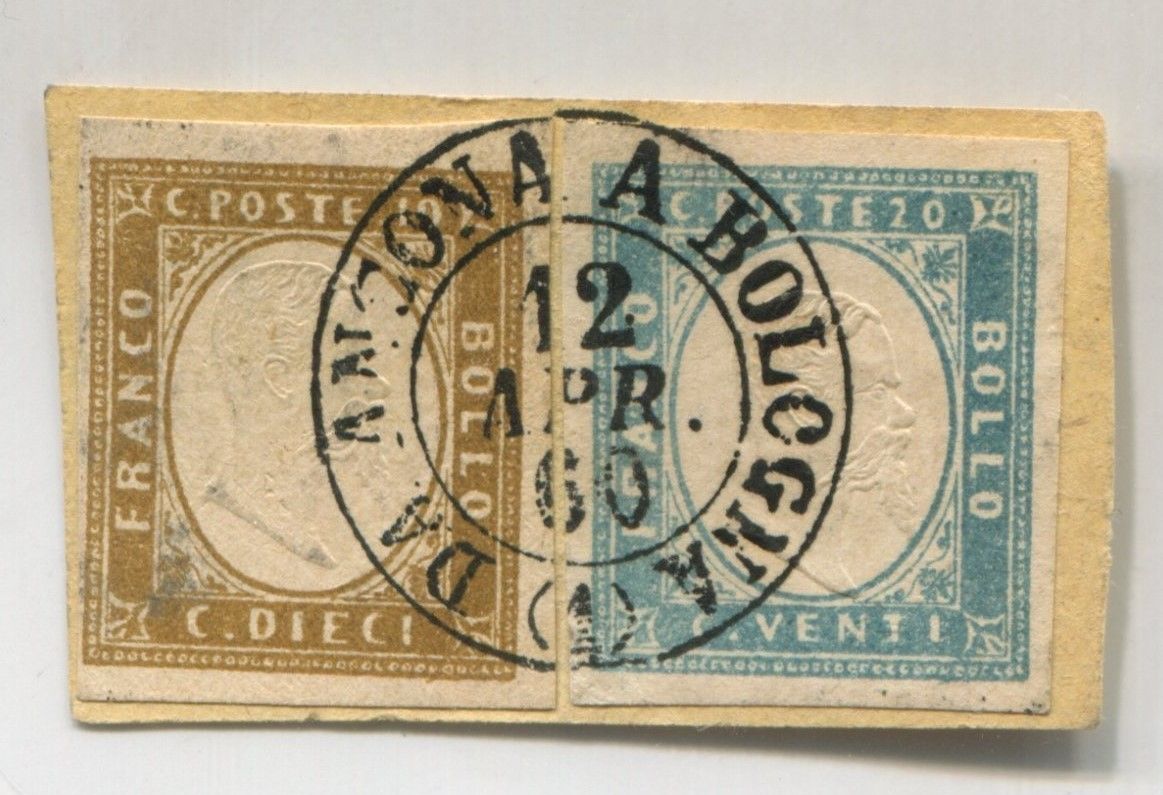
Forgeries of the 20 c, 40 c and 80 c, probably made by the same
forger, the '20', '40' and '80' are not positioned properly,
'QUARANTA' is written as 'OUARANTA' with an 'O'.

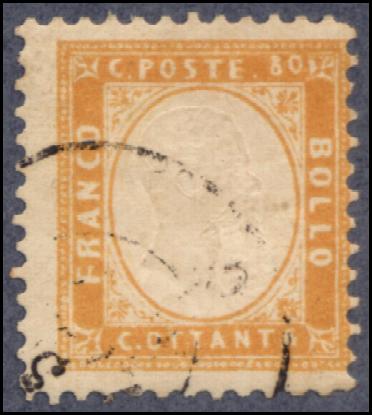
Similar perforated forgeries, pretending to be some of the first
stamps of Italy.

I think this tete-beche pair was also made by the same forger
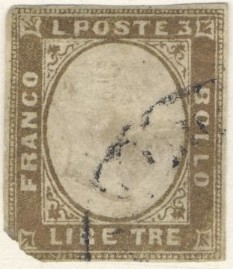
Forgery of the 3 L with different lettering, for example the 'C'
of 'FRANCO' is much more closed and the 'S' is more squeezed.
There is no '-' in front of the '3'.
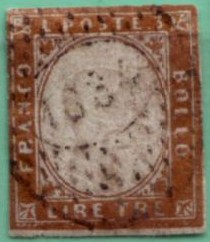
(Forged cancel)
I've seen a forgery of the 3 L with the word 'FRANCO' inverted:
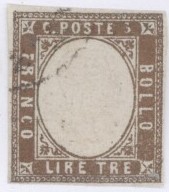
3 L forgery with the word 'FRANCO' inverted

Unclear printed 5 c stamp; most likely a forgery.
1 c grey 2 c grey
A 2 c stamp in yellow was issued in Italy in 1862. Misprints with the embossed '1' on the 2 c frame and the embossed '2' on a 1 c frame exist (very rare in used condition).
Value of the stamps |
|||
vc = very common c = common * = not so common ** = uncommon |
*** = very uncommon R = rare RR = very rare RRR = extremely rare |
||
| Value | Unused | Used | Remarks |
| 1 c | * | * | |
| 2 c | ** | *** | |
Printer's waste:
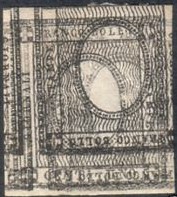
Printer's waste, double impression
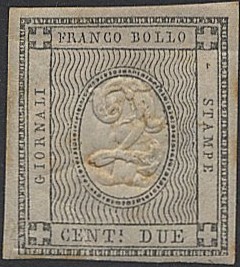
Forgery of the misprint with both the embossed '2' and the
embossed '1' on the 2 c frame
The Billig book of forgeries shows an image of a forgery of the 1 c, with the lettering done more badly than in the genuine stamp (sorry, no image available yet).

(Genuine)

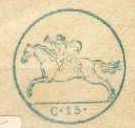


(Reduced sizes, probably reprints or forgeries)
15 c blue 25 c blue 50 c blue The same stamps but embossed
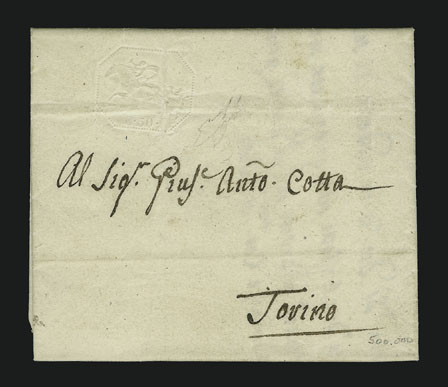
15 c 25 c 50 c
These covers are the first postal stationary to be issued in the world. Forgeries were made of these duty covers (in 1875 by Usigli in Florence using the original plates). These forgeries were quite dangerous and even deceived important collectors (see Le Timbre Poste by Moens, No 267, pages 26-29, 1885). These forgeries were also marketed by the stamp dealer Bonasi. If I'm well informed, these forgeries have a 'star' watermark, which never occurs in the genuine envelopes.
The next cover is forged:
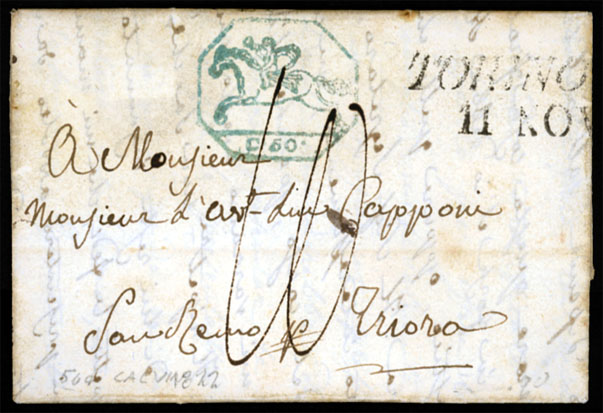
(Forgery)

(Image obtained thanks to Lorenzo)
Other non-issued stamps exist.
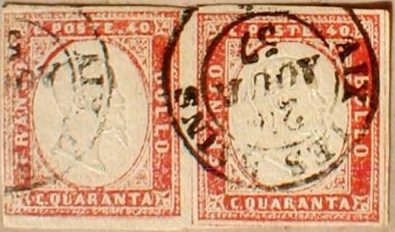
The above stamps are cancelled in Aix les Bains, nowadays situated in France. Aix les Bains is part of the Savoie, which was transferred from Italy to France in 1860.
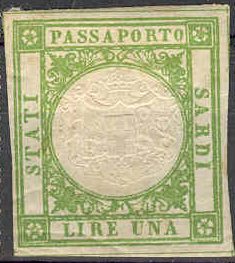
1 L green 3 L blue 10 L red